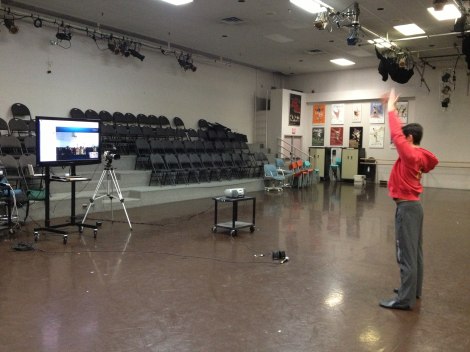
Jaime Vargas, Ballet Master from the Royal Winnipeg Ballet, skyping a movement workshop with the Elgin Street Public School in Ottawa
Image Reproduced with permission from the Royal Winnipeg ballet
Initially, there were the RPM records made of Shellac or vinyl. Then, came the cassettes that had a songs recorded and available for a price. Then, came the VCD’s and DVD’s that flooded the market ranging from tutorials to collector’s edition.
No, I am not talking of movie or cine-songs. I am talking about how Bharatanatyam songs and video have progressed, till date.
Contrast that with dance education, initially aspirants (read as those who wanted to be full time dancers) went to the masters to learn, and stayed with them. Then, there was a time when the masters went to different cities and taught the bright ones. Then, schools were/are established where gurus and students meet few hours in a week and learnt the art form.
I am neither justifying the gurukula system nor the alternate modes of learning, in the current scenario. It is quite obvious that with the exponential advancement of technology, the imparting of education has advanced to some extent in a linear sense. With the arrival of broadband, Skype, and 3G, everyone likes things to be in the finger-touch! It is only natural that online-learning is coming of age. (I am not sure if teachers have now stopped saying “You need to have these knowledge in finger-tips!”)
There have been criticisms on the various modes of education. Take for example, TV channels for teaching. Although, it helps the knowledge reach deeper pockets of a country (DD in India), there is no way to estimate if the student had dozed off in the middle of the program. Same goes with Online videos, too. On the other hand, online courses run by Coursera, require a specific time in a year dedicated to be enrolled. But, the criticism is not only on the method used for imparting knowledge, but also on the instructor (gurus in the case of BN) to adapt to newer technologies.
In the US, online classes have been seen as a way of reducing costs of manpower and infrastructure. However, in India it is not the money, the reasons are quite different. Click for the TIME article about how teachers are using Skype
Recently, the BBC did a report on the increase of online learning of the arts.
Read the full report here
Says Indira Kadambi: “Gurus are not available everywhere. Even if they are, quality education is not available. The online medium makes programmes (lessons) easily available.”
To be honest, this is not the first time dance has been taught online. In any case, online teaching of Carnatic music has been around for many years (e.g. Acharyanet). For students, who have moved to other countries and crave for learning, have been doing this. It goes for dance gurus as well. In a 2011 report by The Hindu, dancer Charulata Jayaraman says
We have fixed schedules for video conferencing. I have wireless cameras installed in the Tiruchi class that I can pan and tilt to monitor the student’s steps and movements. I choreograph sequences and the seniors teach them to the younger kids. My mom is in complete charge of affairs here and it is with the help of my senior students and teachers that I keep the school going.
The first thing that comes as a big hurdle is setting time in normal hours, rather than waking up at ungodly hours. The second is for dance, the student needs to have a proper space to practice, when the guru is not watching. In any case, when I asked around a few responded as below
Music is easier though, especially if the student has been learning for some time. I can’t imagine if I started learning Veena over Skype. If there’s a video lag or something it could be annoying. Its easier now because I don’t have to look at the video sometimes. I can tell which notes to play or how to play them just by listening.
Another responded as
Have mixed feelings. I think the objective for these learning sessions will determine the success. If the learner is an absolute beginner… no chance I guess. Learning theory, dance history etc.. absolutely possible. For mature student who have a good base already may be a possibility.
Send us your comments by filling the poll below.
References:
http://www.bbc.co.uk/news/business-22516037
http://www.thehindu.com/features/friday-review/dance/dance-is-her-way-of-life/article1327765.ece
http://techland.time.com/2012/11/28/how-teachers-use-skype-in-the-classroom/
Comment posted in the poll, reproducing it below
Being a dancer and a dance teacher myself I always had an urge to make dance more approachable for the the lay audience , to increase its popularity this is very necessary and and I also developed an app for self understanding of this art form ….. with the help of some tech students and it was presented at a research conference …. was well appreciated….. the need of the hour is to make classical dance more available for gen crowd so that it does not perish and be called a dead art form with no scope for future or further development. – Priya Dinesan
Pingback: Dance, Dancers, and Technology | Bharathanatyam and the worldwide web·